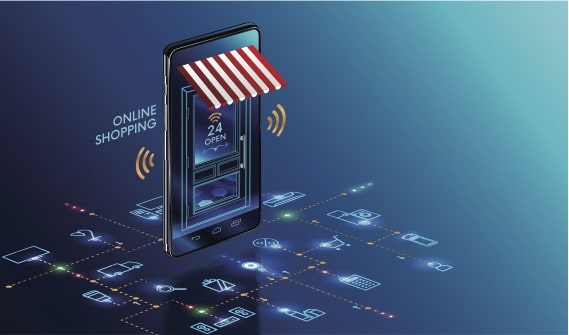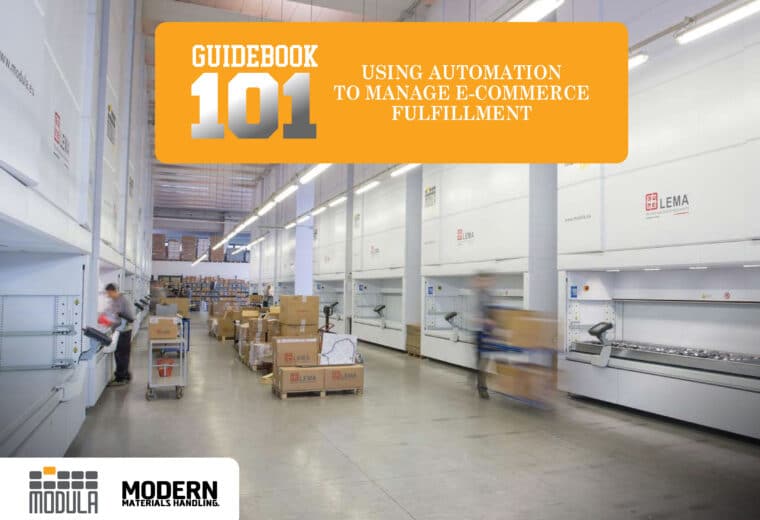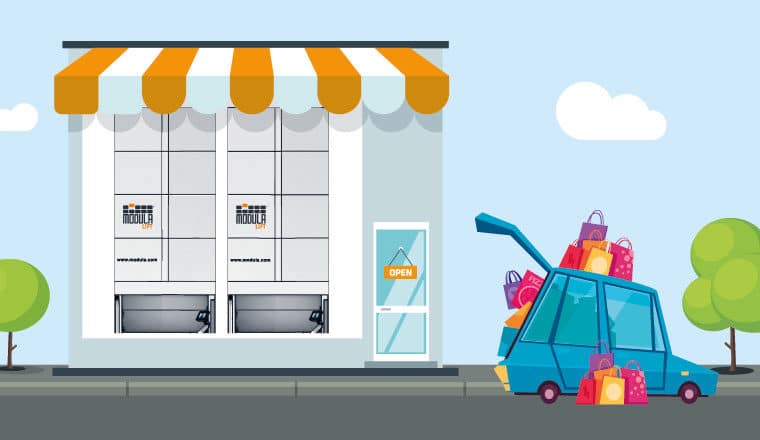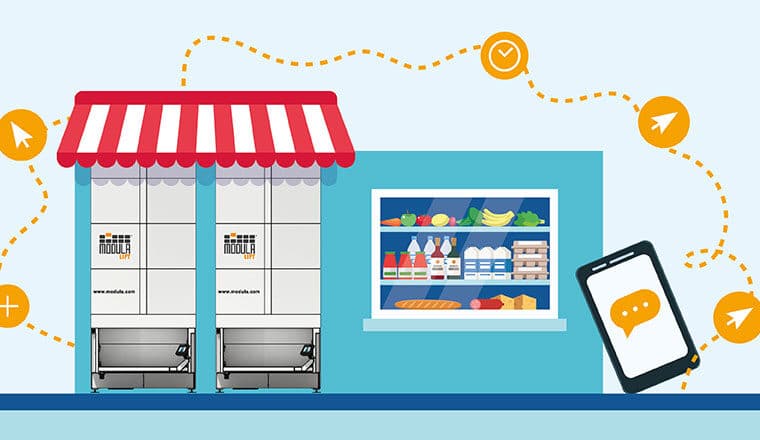How To Automate E-grocery Logistics: From Storage to Picking
Facing the challenges of increased demand and e-grocery logistics? Explore Modula automated storage systems & picking solutions to optimize your operation.
The continuous increase in the demand for home deliveries and in-store pickup of mass-market retailer products has been seen around the globe — especially in the U.S. and Europe.
Along with the increase in demand, we’ve seen that traditional manual picking methods are not able to meet market needs. Particularly in terms of speed and efficiency. This poses new challenges for inventory management, increases operating costs, and can negatively impact the shopping experience of customers who have to wait to collect their orders from in store lockers.
The solution: Automation.
The automation of e-grocery logistics and picking is the key to meeting the needs of increasingly demanding consumers who purchase more online than ever.
The mass-market retail sector develops logistics solutions based on automated storage systems and automated picking systems for order preparation. To do this, the industry adopts the best practices and technologies used in large distribution and logistics hubs.
Omnichannel Strategies in the Mass Market Retail Sector and Their Impact on E-grocery Logistics
Today, grocery retailers need to be seamlessly present on the market both online and offline, as consumers visit both physical and online stores.
Focusing on omnichannel retail means identifying methods to create connected systems where physical and digital channels can share information. In this way, customers can enjoy a consistent shopping experience across the board.
Delays between these two channels can generate a gap, known as a “convenience gap.” This gap may be between the retailer and the consumer or between expectations and reality, and it may limit the adoption of online shopping.
According to a recent McKinsey report, e-grocery in the U.S. could account for 10% of the total grocery turnover by 2025, thanks to the development of the omnichannel approach.
Consumers are ready for this new way of shopping and omnichannel strategies are essential to reduce the “convenience gap” and offer a series of benefits to both customers and retailers.
These benefits include:
Omnichannel inventory
Omnichannel inventory is the creation of an inventory system that controls the flow of products between stores, distribution hubs and home deliveries in real-time. This enables retailers to monitor stock and promptly inform customers about the availability of any given product.
Combined online-offline purchases
Some customers feel the need to buy certain products in person. For example, fruit, vegetables, and other fresh food products. For many people, even a detailed description in an e-commerce website cannot compete with an in-person evaluation.
An omnichannel approach offers customers both choice and flexibility: they can buy packaged and durable products online and have them delivered to their home while picking up fresh products in-store.
Smart supply chain
A multichannel system enables retailers to build smart supply chains, synchronized across all channels to increase overall efficiency. As a result, Customers can use all channels with the same level of satisfaction. On the other hand, retailers gain additional control over product flows and have access to more information about customer preferences.
This profound change in the world of mass-market retailers is having a big impact on the logistics sector. The rapid growth of e-grocery brings significant organizational changes that involve a necessary strengthening and broadening of the entire infrastructure.
Let’s take a look at how e-grocery is driving innovation in logistics, supported by automation and automated picking systems.
The Covid-19 Pandemic’s Effect on E-grocery
There is no doubt that the grocery sector has faced significant challenges in the last few years. The Covid-19 pandemic, with the consequent surge in e-commerce, has fueled the revolution which was already underway.
According to the eMarketer forecast, online grocery sales grew by 54% in 2020 to reach $95.82 billion. That propelled it to a 12% share of total U.S. e-commerce sales and 7.4% of all grocery sales. By the end of 2021, online grocery sales are expected to surpass $100 billion.
To remain competitive and keep pace with the new purchasing paradigm, increasingly digital or hybrid, the players in the sector must reorganize their operations and implement automated and innovative solutions.
The two most common solutions offered by mass-market retailers and exploited by consumers are BOPIS and BOSS.
In both scenarios, the retailer that fails to deliver a quality experience risks disappointing its customers. As a result, the customers may decide to avoid the same purchasing method and/or avoid the retailer altogether.
Keeping customers updated and making their shopping experience as smooth as possible is critical to success.
The transition to online shopping and the adoption of an omnichannel strategy involves the reorganization and rekitting of warehouses.
In this context, Micro (or Urban) Fulfillment Centers (MFC’s), small logistic hubs distributed throughout high population urban areas, have been developed to meet the growing needs of the e-grocery sector.
MFC’s are typically equipped with automated storage and order preparation systems that make micro fulfillment a winning strategy for both order management and quick deliveries.
E-grocery Automation Segmentation and Modula as a Supplier of Material Handling Equipment (MHE)
The e-grocery sector can benefit from automation in three key areas:
- MHE (Material Handling Equipment): the management of materials
- Software: online ordering apps, for example
- Delivery: curbside pickup, lockers, last mile solutions
Thanks to our automated vertical storage solutions, Modula is now a point of reference as an international supplier of MHE for MFC’s and the like, where the use of automated goods-to-person systems and space optimization tools are always critical.
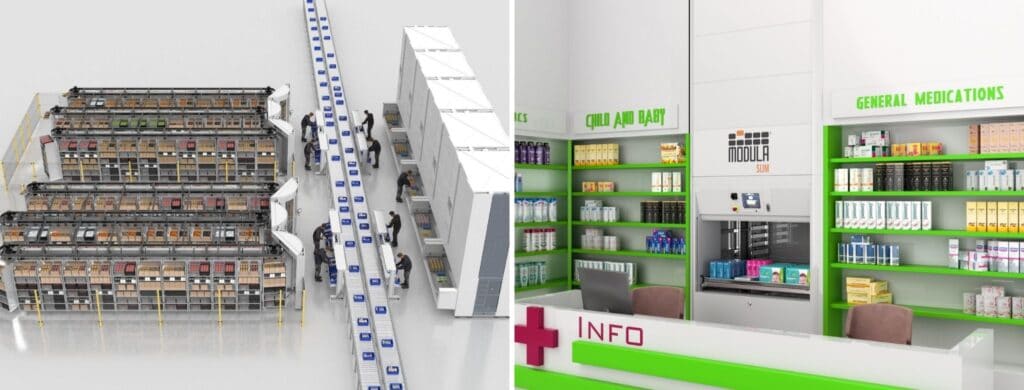
The Importance of Space in Storage Systems
Micro fulfillment is based on automated storage systems and picking robots that can also be installed in small warehouses, where they can fulfill thousands of orders a week.
Modula automated vertical storage systems are a highly effective solution because they simultaneously maximize the use of space and speed up the picking phase. This guarantees cost reduction in terms of storage area and transport.
The 4 Advantages of Modula E-grocery Solutions
Modula offers solutions that respond to the new needs of Mass Market Retailers and e-grocery. Modula storage systems are:
Modularity
Modula’s products for e-grocery logistics are an ideal solution for any logistics hub.
With a high density and tiny footprint, our automatic storage systems are modular and customizable, which allows them to scale alongside your business.
Easy to install, easy to integrate with our WMS
Modula vertical storage systems are installed in just one week and can be easily integrated with the customer’s ERP systems. The Modula WMS software application is simple and intuitive.
Easy to combine with automated picking systems
Modula automated storage systems can be easily integrated with most MHE systems, independently of whether they are Modula picking solutions or not. They guarantee a fast and efficient picking management system, capable of adapting even to intense work peaks.
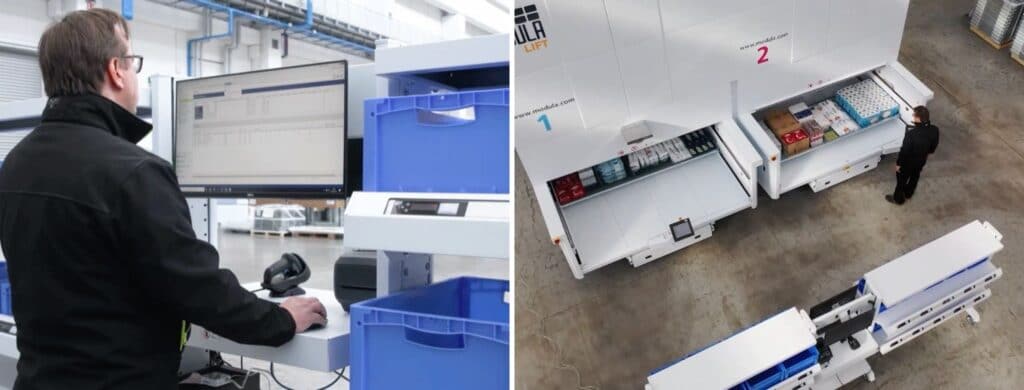
Perfect for the management of fresh and dry food products
Moreover, our automated storage systems are also available in a controlled temperature version, called Modula Climate Control. In this version, Modula Lift supports the cold chain operating in a temperature range from 35F to 77F (± 1°C), with a maximum humidity of 50%.
Interested in discovering more about how logistics automation can enhance e-commerce and overcome the obstacles and difficulties that characterize warehouse management?
Find out how our Vertical Lift Modules and Horizontal Carousels can help you efficiently manage e-commerce order fulfillment.


